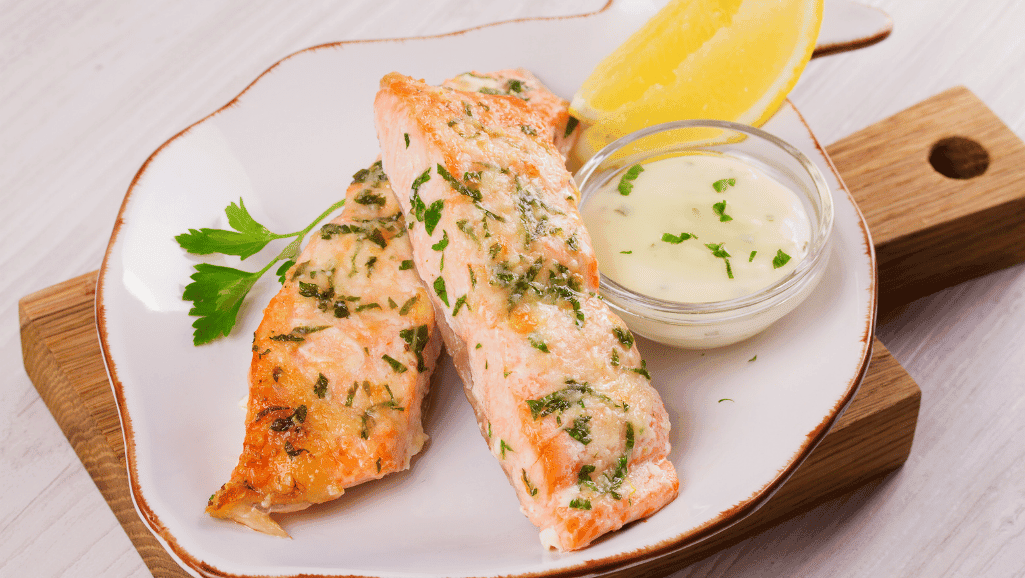White fish is a great choice for a healthy diet. It’s full of vitamins and minerals that help keep you well. Eating white fish can boost your bone health and fight inflammation.
White fish is packed with 23 grams of protein per serving. This is a lot of protein, which is good for your cells and helps with weight control. It also has a high protein-to-energy ratio, which is good for energy.
White fish is also rich in vitamins and minerals. It has lots of vitamin D, which is good for your bones and immune system. It also has vitamin B12, which is important for your nerves and blood cells.
Phosphorus in white fish helps keep your bones strong. This can help prevent conditions like osteoporosis. Vitamin B6 in white fish fights inflammation, which is good for people with asthma and arthritis.
Vitamin B3 in white fish boosts your immune system and helps you recover from infections. Pregnant women should eat white fish for vitamin B2 to reduce miscarriage risk and support liver function. The nutrients in white fish also help with cell renewal, which can slow down aging.
White fish is easy to add to a healthy diet because it’s versatile and low in fat. It’s good for weight management because it’s low in calories and fat. It also keeps you full for a long time. For more info on white fish benefits, visit Global Seafoods.
Key Takeaways
- White fish is a nutrient-dense seafood option that provides essential vitamins and minerals.
- White fish is an excellent source of high-quality protein, aiding in cellular functions and weight management.
- White fish’s versatility in cooking makes it suitable for a variety of recipes
- Vitamin D in white fish supports bone strength and immune function.
- White fish contains vitamin B12, essential for healthy nerve function and red blood cell production.
- The low fat content and high satiety score of white fish make it an ideal choice for a healthy diet.
Lemon Herb White Fish
4
servings10
minutes15
minutes250
kcalA delightful and healthy white fish recipe with lemon and fresh herbs.
Keep the screen of your device on
Ingredients
4 fillets 4 white fish
2 tablespoons 2 olive oil
1 teaspoon 1 lemon zest
2 tablespoons 2 lemon juice
3 cloves 3 garlic, minced
1 tablespoon 1 fresh parsley, chopped
1 teaspoon 1 salt
0.5 teaspoon 0.5 black pepper
1 teaspoon 1 dried thyme
Directions
- Preheat the oven to 400 degrees Fahrenheit. Grease a baking dish with olive oil and set aside for later use.
- Place the fish fillets in the prepared baking dish. Drizzle them with olive oil, making sure to coat each fillet evenly.
- In a small bowl, combine lemon zest, lemon juice, minced garlic, chopped parsley, salt, pepper, and dried thyme. Mix well to make the seasoning.
- Pour the lemon herb mixture over the fish fillets, ensuring that they are completely covered with the flavors of the mixture.
- Bake in the preheated oven for about 15 minutes, or until the fish flakes easily with a fork and is thoroughly cooked.
- Remove the baking dish from the oven, allow the fish to cool slightly, and serve garnished with additional fresh parsley if desired.
Recipe Video
Nutrition Facts
- Total number of serves: 4
- Calories: 250kcal
- Cholesterol: 85mg
- Sodium: 350mg
- Potassium: 600mg
- Sugar: 0g
- Protein: 36g
- Calcium: 30mg
- Iron: 2mg
Introduction to White Fish and Its Nutritional Value
White fish, like cod, haddock, halibut, and sole, are nutritional powerhouses. They are rich in essential nutrients. These mild-flavored fish are a lean source of protein. This makes them great for a healthy diet.
Most lean fish, such as cod, flounder, and sole, have 100 calories or less per 3 ounces cooked. This makes them a low-calorie choice for those watching their diet.
White fish are also low in fat. They contain valuable omega-3 fatty acids, important for heart health and brain function. Eating white fish regularly gives you many vitamins and minerals for good health.
“People consuming high fish diets, measured by omega-3 levels, can live over two years longer compared to those eating the least fish.”
The U.S. dietary guidelines suggest eating seafood twice a week for health benefits. Seafood is a big part of the daily recommended protein in a 3 ounce cooked serving. Adding white fish to your diet helps meet protein needs while keeping fat and calories low.
Macronutrients in White Fish: Protein and Healthy Fats
White fish is a nutritional powerhouse, packed with essential macronutrients that support overall health and well-being. It has a high white fish protein content of 20.8g per serving, making up 42% of its total calories. This makes it an excellent choice for those looking to maintain or build muscle mass.
White fish is not just a great source of protein. It also contains all the essential amino acids needed for tissue repair and maintaining a healthy body. These amino acids are vital for hormone production and immune system support.
High-Quality Protein Content
White fish is known for its high-quality protein content. With 19g of protein per serving, it provides a significant portion of the daily recommended intake. It is considered an incomplete source of protein, lacking one or more essential amino acids. But, when combined with other protein sources, it can contribute to a balanced diet.
Omega-3 Fatty Acids
White fish has lower levels of omega-3 fatty acids than oily fish. Yet, it still offers these heart-healthy fats. It contains 1.548g of omega-3 fatty acids, which is 97% of its total omega-3 content. These fats are vital for body and brain function and can help reduce the risk of many diseases, including:
- Cardiovascular disease
- Inflammatory conditions
- Neurodegenerative disorders
“Eating white fish regularly can be a simple and delicious way to support heart health and overall well-being.”
White fish also contains a small amount of omega-6 fatty acids (0.297g), which is 2% of its total omega-6 content. While omega-6s are important for health, it’s key to keep a balance between omega-3 and omega-6 intake for optimal health.
Micronutrients in White Fish: Vitamins and Minerals
White fish, like cod and tilapia, is full of protein, healthy fats, and vitamins and minerals. These nutrients are key for health, supporting the nervous system, bones, and immune system.
B Vitamins for Nervous System and Blood Cell Health
White fish is rich in B vitamins, like B6 and B12. These vitamins are vital for a healthy nervous system and making red blood cells. Eating enough B vitamins from white fish can prevent anemia, fatigue, and neurological problems.
Vitamin D for Bone Strength and Immune Function
Vitamin D in white fish is crucial for strong bones and immune health. It helps the body absorb calcium and fight infections. Adding white fish to your meals can boost your vitamin D levels.
Minerals: Phosphorus, Calcium, Iron, Zinc, Iodine, Magnesium, and Potassium
White fish is rich in minerals that help the body function well. For instance:
- Phosphorus and calcium are essential for strong bones and teeth.
- Iron is vital for carrying oxygen and making red blood cells.
- Zinc boosts immune health, wound healing, and growth.
- Iodine in cod is key for thyroid health, preventing goiters and hypothyroidism.
- Magnesium and potassium are important for muscles, nerves, and blood pressure.
Eating white fish ensures you get many essential minerals for health. These nutrients help the body’s systems work well, including the nervous, skeletal, and immune system support.
White Fish and Its Role in a Healthy Diet
Adding white fish to your diet is a smart move for a healthy life. Fish like Pacific Cod and Alaskan Pollock are low in fat and calories. This makes them great for those trying to lose weight or keep their heart healthy.
White fish is packed with protein, which helps with weight control and energy. It’s also low in fat, which can help with losing weight. Cod and Pollock are excellent choices for this reason.
White fish is easy to cook in many ways, making it a versatile choice. You can bake, grill, pan-fry, or poach it. This variety makes it simple to add white fish to your meals often. The American Heart Association suggests eating fish twice a week for a healthy diet. Eating fish regularly can lower heart disease risk by 15%.
Low in Fat and Calories
White fish is naturally low in fat and calories. This makes it perfect for those trying to stay at a healthy weight or reduce heart disease risk. It has less LDL cholesterol than other proteins, which can lower blood pressure and heart disease risk.
By eating white fish, you get a lean, nutritious protein that supports your health. It’s a great choice for a balanced diet.
Versatility in Cooking Methods
White fish is very versatile in cooking. You can bake, grill, pan-fry, or poach it. This means you can try different flavors and spices, keeping your meals exciting.
Exploring different cooking methods can also help you enjoy white fish’s health benefits in new ways. It’s a fun way to keep your meals interesting.
Recommendations for Consumption
While white fish is good for you, it’s important to know about mercury levels in some fish. The U.S. Food and Drug Administration advises pregnant and breastfeeding women to eat low-mercury fish like salmon and trout. They should avoid raw fish to protect the fetus.
For everyone else, eating fish once or twice a week is recommended. This helps meet omega-3 fatty acid needs and can lower risks of asthma, depression, and macular degeneration. By following these guidelines and eating white fish, you can enjoy its nutritional benefits.

















